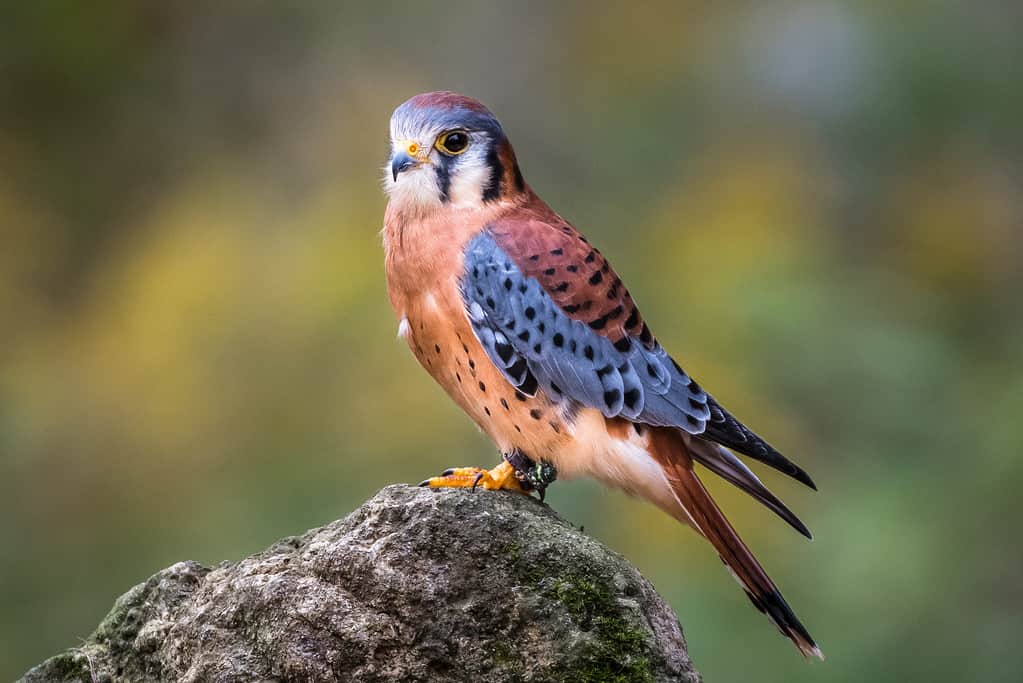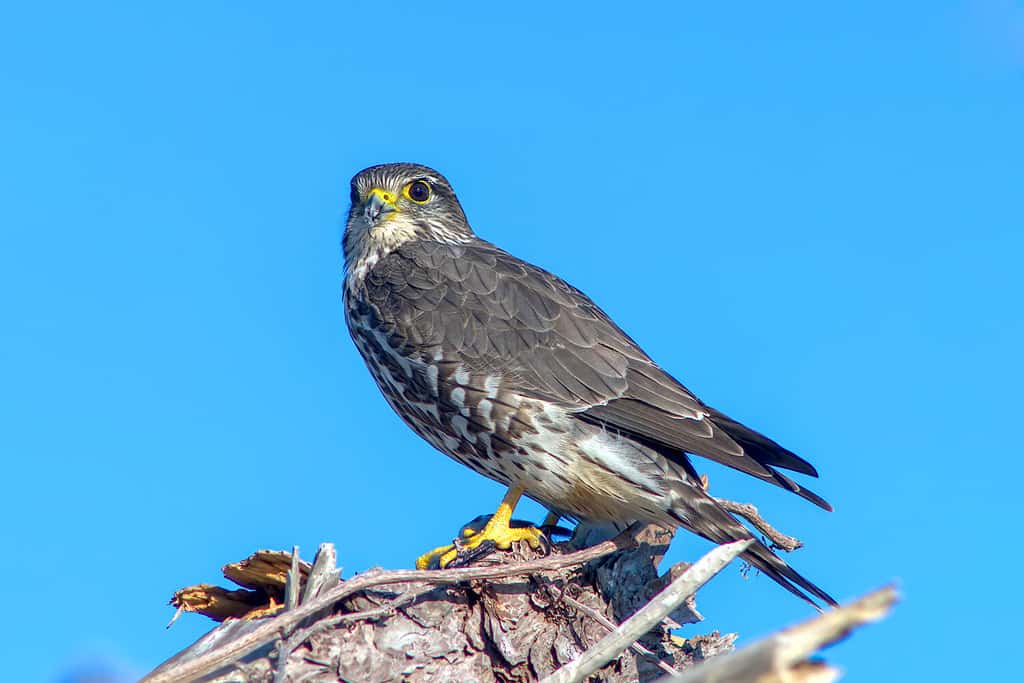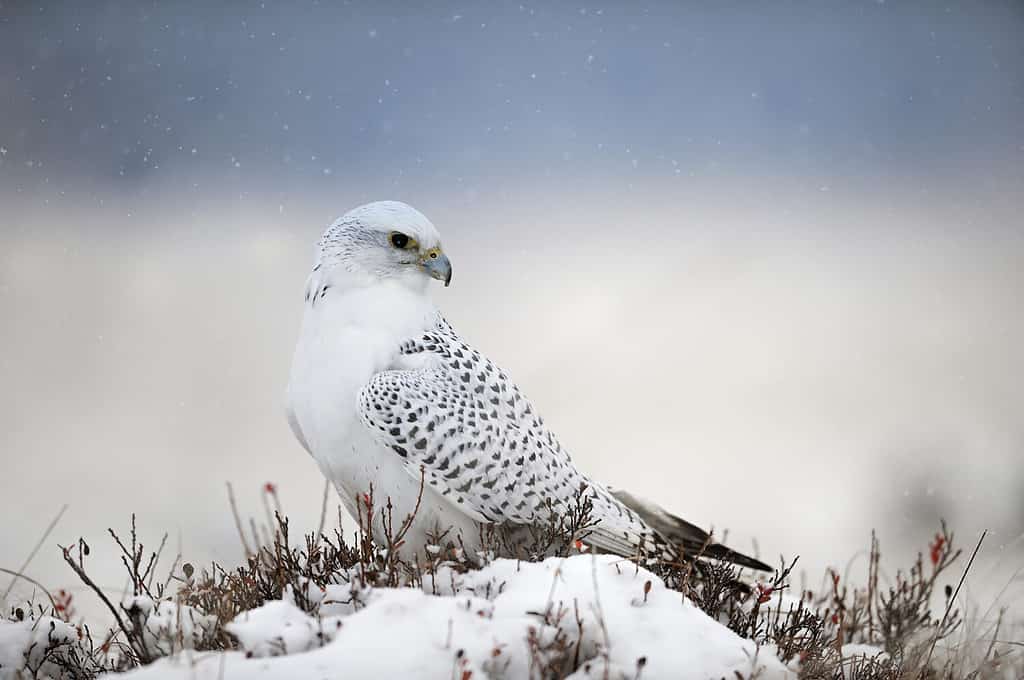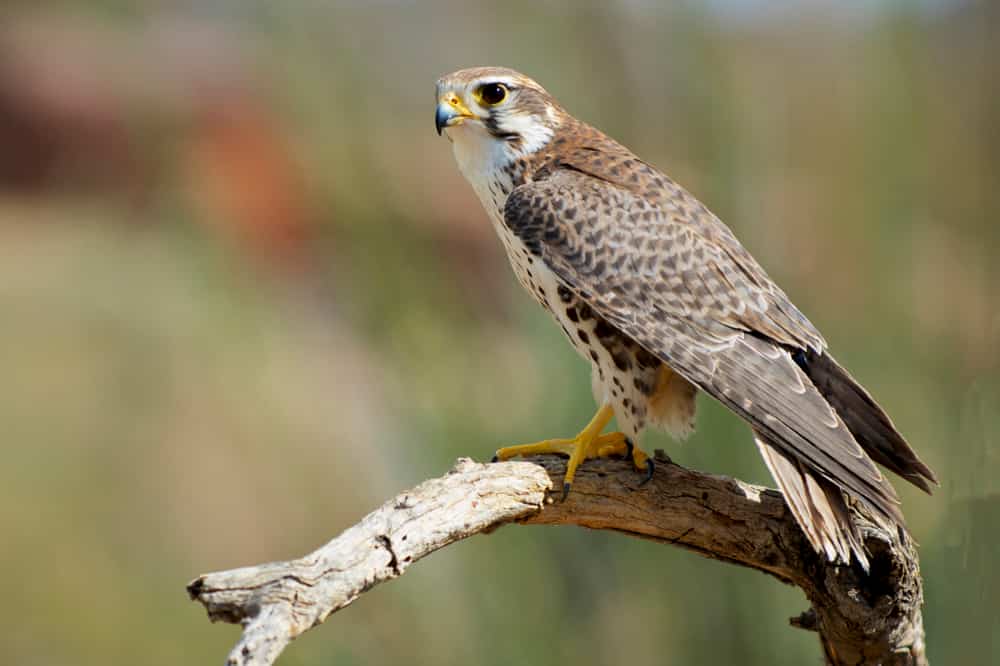Pennsylvania is home to three native falcon (Falco spp.) species. Additionally, two other falcon species appear in records in the state as rare vagrants. Read on to meet each of the five falcons found in Pennsylvania, plus find out what they look like and where they live.
1. American Kestrel (Falco sparverius)

The American kestrel is the smallest, most abundant, and most colorful falcon in North America.
©Katie Duncan-Burt/iStock via Getty Images
Length: 8.7 – 12.2 in (22 – 31 cm)
Weight: 2.8 – 5.8 oz (80 – 165 g)
Wingspan: 20.1 – 24.0 in (51 – 61 cm)
(females larger than males)
The American kestrel is unusual amongst raptors because the male and female have strikingly different plumage patterns. Both sexes have a rust-brown back and tail, spotted white breast, and white face with two vertical black bars. However, the male has slate-blue wings, while the female has rufous wings as well as dark banding on the tail. Juvenile plumage resembles the adult.
American kestrels are year-round residents across the state. They commonly appear in agricultural areas and grasslands and perched on poles and fences along roadsides. They are cavity nesters and readily accept artificial nest boxes.
2. Merlin (Falco columbarius)

The merlin is only slightly larger than the American kestrel, though it is heavier with a noticeably more robust build.
©Noah Li/Shutterstock.com
Length: 9.4 – 11.8 in (24 – 30 cm)
Weight: 5.6 – 8.5 oz (160 – 240 g)
Wingspan: 20.9 – 26.8 in (53 – 68 cm)
(females larger than males)
There are three subspecies of merlin in North America, with males of each subspecies having different plumage coloration varying from pale to dark. The subspecies present in Pennsylvania is of an intermediate shade — generally slate blue-gray above and pale with heavy streaking below, with dark underwings and a dark tail with narrow white banding. Female and juvenile plumage is browner overall.
As a migratory species that breeds primarily in northern latitude conifer forests, merlins were once only seen in Pennsylvania during autumn migration season as they flew south for the winter. However, the species has been gradually expanding its breeding range southward, and the northernmost part of the state now falls within its southernmost breeding range.
3. Peregrine falcon (Falco peregrinus)

With its incredible vertical flight velocity of 242 mph (389 kph), the peregrine falcon is the fastest animal in the world.
©Harry Collins Photography/Shutterstock.com
Length: 14.2 – 19.3 in (36 – 49 cm)
Weight: 18.7 – 56.4 oz (530 – 1600 g)
Wingspan: 39.4 – 43.3 in (100 – 110 cm)
(females larger than males)
The peregrine falcon is steely blue-gray above and white with heavy barring below, with a dark head and mustache. Juvenile plumage is distinguished by heavy vertical streaking rather than horizontal barring on the chest.
Peregrine falcons are year-round residents of the state. They naturally nest on ground scrapes along cliffsides. However, in modern times they have adapted well to urban areas and now can be spotted in cities nesting on tall buildings and bridges as well — and hunting lots of pigeons!
4. Gyrfalcon (Falco rusticolus)

The gyrfalcon is the world’s largest falcon species.
©Michal Pesata/Shutterstock.com
Length: 18.9 – 25.2 in (48 – 64 cm)
Weight: 28.2 – 74.1 oz (800 -2100 g)
Wingspan: 48.4 in (123 cm)
(females larger than males)
While portrayals of the gyrfalcon commonly include its white morph plumage, there are also dark brown and gray morphs, with the latter being the most numerous form in North America. In all morphs, the plumage is barred on the back, wings, and tail, with variable spotting on the underparts. Juvenile plumage is distinguished by heavy streaking on the underparts.
Gyrfalcons breed in the high Arctic. During winter, many disperse further south, including into Canada and the northernmost regions of the United States. While Pennsylvania is well south of this usual dispersal range, a few wayward individuals are recorded as rare visitors to the state a handful of times in recent decades, most recently in 2018.
5. Prairie falcon (Falco mexicanus)

As residents of arid regions, prairie falcons take dust baths more often than water baths.
©Danita Delimont/Shutterstock.com
Length: 14.6 – 18.5 in (37 – 47 cm)
Weight: 14.8-38.8 oz (420 – 1100 g)
Wingspan: 35.4 44.5 in (90 – 113 cm)
(females larger and heavier)
The prairie falcon is a sandy brown above and pale with brown mottling below, with a white stripe over the eye and a brown mustache stripe. In flight, they can be identified by their prominent dark wingpits. Juvenile plumage is distinguished by heavy streaking on the underparts.
Prairie falcons are native to arid regions of Western North America. It is not as migratory as other North American falcons, typically only moving out of the coldest extremes of their breeding range and dispersing short distances still well to the west of Pennsylvania. However, wayward individuals have been recorded as rare visitors to the state a handful of times in recent decades, most recently in 2014.
Summary of 5 Falcons Found in Pennsylvania
| Species | Status In PA |
|---|---|
| 1. American Kestrel (Falco sparverius) | native, year-round resident across the state |
| 2. Merlin Falco columbarius | native, breeds in the northernmost part of the state, seen statewide during autumn migration |
| 3. Peregrine falcon Falco peregrinus | native, year-round resident across state |
| 4. Gyrfalcon Falco rusticolus | rare vagrant, last recorded in 2014 |
| 5. Prairie falcon Falco mexicanus | native, year-round resident across the state |
The photo featured at the top of this post is © Harry Collins Photography/Shutterstock.com
Thank you for reading! Have some feedback for us? Contact the AZ Animals editorial team.






